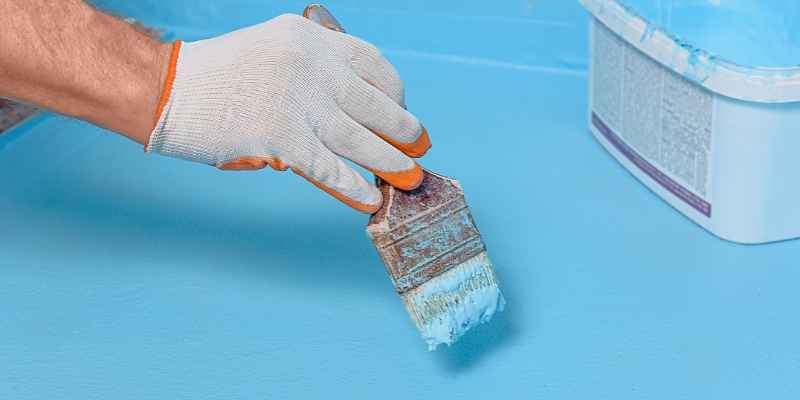To waterproof wood for a bathroom, apply a film-forming varnish to protect it from external aggressions such as water and humidity. Wood adds a natural warmth to a bathroom, making it a popular choice for vanity tops, paneling, and other fixtures.
However, because bathrooms are humid environments, untreated wood is susceptible to moisture damage over time. Therefore, it is essential to take measures to waterproof wood to prevent it from rotting or warping. This article provides various methods for waterproofing wood in a bathroom, including using oils such as linseed oil, tung oil, or Danish oil, sealing it with a film-forming varnish, and painting it with a waterproof paint.
We will also share tips on how to maintain and care for waterproofed wood to ensure its longevity in a bathroom.
Various Methods To Waterproof Wood For Bathrooms
Protecting wood in the bathroom requires treating it with oils, varnishes, or paints to prevent moisture from penetrating. Natural oils like linseed, tung, or Danish oils can be brushed or wiped on to create a waterproof barrier, while polyurethane and sealants also work effectively.
Wood is a commonly used material in bathrooms for shelves, countertops, and even floors. However, wood is not naturally waterproof, making it susceptible to damage and rot when exposed to moisture. Luckily, there are various methods to waterproof wood for bathrooms. In this article, we will discuss some of the most effective and simple methods to waterproof wood for bathroom use.
Using Linseed and Tung Oil
Linseed oil and tung oil are natural oils that can be used to waterproof wood effectively. These oils penetrate deep into the wood, creating a barrier that keeps water out. When blended together, these oils create a durable and waterproof seal for bathroom wood items.
To use linseed and tung oil, mix equal parts of both oils and apply to the wood surface using a cloth. Allow the oil mixture to sit for some time and wipe off any excess oil with another cloth. The wood surface will be highly polished, waterproof, and safe for bathroom use.
Sealing Unfinished Wood
Unfinished wood is a porous material, and it usually absorbs water quickly. A simple way to waterproof unfinished wood is by using a sealant. A sealant creates a protective barrier on the wood’s surface, preventing moisture and water from penetrating it.
To seal unfinished wood for bathroom use, apply a thick coat of sealant on the surface using a brush. Allow the sealant to dry and apply another coat if necessary. A waterproof sealant will protect the wood and make it more durable.
Stain and Sealant Combo
If you want to add color to the wood and waterproof it simultaneously, a stain and sealant combo is an excellent option. The combination of stain and sealant will help the wood resist stains, odors, and moisture while providing it with a glossy and elegant finish.
To use a stain and sealant combo, apply the stain first and allow it to dry completely. Then apply a waterproof sealant and let it dry as well. Keep in mind that using the right amount of stain is essential to avoid over-saturating the wood.
Waterproofing Painted Wood
Painted wood is already sealed and protected, but it may not be fully waterproof. Adding a waterproof topcoat to the painted wood can make it more resistant to moisture and water damage.
To waterproof painted wood, apply a waterproof topcoat over the paint using a brush or roller. Make sure to spread the topcoat evenly on the surface and allow it to dry completely. The waterproof topcoat will provide added protection to the painted wood.
Conclusion:
Waterproofing wood for bathroom use is essential to prevent water damage and make it more durable. Use natural oils like linseed and tung oil, sealant, stain and sealant combos or waterproof topcoat on painted wood to effectively waterproof for bathroom use. Choose the method that fit with the type of wood you are using and the desired finish.

Natural Oils For Waterproofing Wood
Natural oils like linseed, tung, or Danish oil can be used to waterproof wood for bathroom applications. These oils can be brushed or wiped on with a cloth, have a short re-coat time, and are usually ready to be touched soon after.
It’s also important to treat all woods with oils, varnishes, or paints to prevent moisture from penetrating them.
Natural Oils for Waterproofing Wood
When it comes to waterproofing wood for the bathroom, there are various natural oils that can get the job done. These natural oils include Linseed oil, Tung oil, and Danish oil, which can keep your wooden bathroom fixtures safe from water damage.
Linseed Oil
Linseed oil is a natural oil that derives from flax seeds. This oil is very common in the woodworking industry and is a popular option for waterproofing wood for the bathroom. Linseed oil forms a protective layer on the wooden surface, preventing moisture from penetrating and causing damage over time. One way to use Linseed oil is to mix it with mineral spirits and apply it to the wood using a cloth or brush.
Tung Oil
Tung oil is another natural oil that is commonly used for waterproofing wood in the bathroom. This oil is extracted from the nuts of the Tung tree and is known for its ability to dry quickly. Tung oil creates a tough and waterproof barrier on the wood surface, protecting it from water, stains, and scratches. Applying tung oil is also very simple, and it can be brushed or wiped onto the wood surface.
Danish Oil
Danish oil is a mixture of Tung oil and varnish, making it an excellent choice for waterproofing wood for the bathroom. It offers great protection against moisture while also enhancing the natural beauty of the wood with its blend of oils and resins. Danish oil is an easy-to-use alternative to traditional varnish as it can be applied smoothly with a cloth or brush.
In conclusion, natural oils are an affordable and eco-friendly option for waterproofing wood in your bathroom. Whether you choose Linseed oil, Tung oil, or Danish oil, always ensure that the wood is clean and dry before applying the oil. Furthermore, follow the manufacturer’s instructions on the packaging to achieve optimal results.
Supplies Needed To Waterproof Wood For Bathrooms
Waterproofing wood for bathrooms requires treatments like varnishes, paints, or oils like linseed, tung or Danish oil. Treatments create a film on the surface that prevents water and humidity from causing damage to the wood, protecting your investment and keeping your bathroom looking new.
Water can be incredibly damaging to wood. In a bathroom, moisture and spills from the sink, shower or bathtub can easily penetrate untreated wood and cause it to rot, warp or even grow mold. Waterproofing wood for your bathroom is a wise and essential investment to help preserve and protect your furniture and flooring.
If you’re ready to waterproof your wood, here are the supplies you will need to get started:
Brush Or Spray Wood Sealant
One of the most important supplies you’ll need is a wood sealant. This can be a brush-on or spray-on product that creates a barrier that water cannot penetrate. There are many different types of sealants to choose from, including polyurethane, epoxy, and varnish. Be sure to choose a sealant that is specifically designed for bathroom use and follow the manufacturer’s instructions for application.
Clean And Sand The Wood
Before applying a sealant, you’ll need to prepare the wood surface by cleaning and sanding it to remove any dirt, grime, or rough patches. Use a sandpaper with a fine grit to smooth out the surface of the wood. Ensure that the wood is completely dry before applying any sealant.
Well-ventilated Space
It’s essential to work in a well-ventilated space when applying wood sealant. Proper ventilation prevents the buildup of fumes, which can be harmful to your health. While working, make sure to open windows or doors, and use fans to circulate the air. If possible, wear a mask to protect your lungs.
In conclusion, waterproofing wood in your bathroom can help to protect your furniture or flooring from water damage, rot, warping, and mold growth. By using a wood sealant, cleaning and sanding the wood surface, and working in a well-ventilated space, you can ensure that your wood surfaces remain in excellent condition and minimize the effect of water damage.
Remember to read the manufacturer’s instructions carefully before using any sealant and seek advice from professionals if you’re unsure.
Frequently Asked Questions For How To Waterproof Wood For Bathroom
Can You Make Wood Waterproof For Bathroom?
Yes, you can make wood waterproof for a bathroom by treating it with oils, varnishes, or paints to prevent moisture from penetrating it. Use film-forming products like varnishes to create a light film on the surface of the wood, resistant to external aggressions like water and humidity.
Natural oils for waterproofing wood include linseed oil, tung oil, and Danish oil. These oils can be brushed or wiped on the wood and have a short re-coat time. Thompson’s Water Seal waterproofing products are also an option.
What Is The Best Sealant For Wood In A Bathroom?
Film-forming varnishes or paints are the best sealants for wood in a bathroom to prevent moisture penetration. Natural oils, such as tung oil and Danish oil, can also be used. Avoid using untreated wood in the bathroom.
How Do I Protect My Bathroom From Moisture In Wood?
To protect your bathroom from moisture in wood, it’s essential to treat the wood with oils, varnishes or paints that make it resistant to water and humidity. Never use untreated wood in the bathroom. Natural oils like linseed, tung, or Danish oil can be used to waterproof the wood.
Brush or wipe the oil on the surface of the wood to form a light film. Allow the oil to dry completely before recoating. Always work in a well-ventilated space.
What Do You Put On Wood In A Bathroom?
To prevent moisture from penetrating wood in a bathroom, it is essential to treat it with oils, varnishes or paints. Natural oils like linseed oil, tung oil, or Danish oil can be used to waterproof wood and protect it from external aggressions like water and humidity.
Avoid using untreated wood in the bathroom.
Conclusion
Waterproofing wood for bathroom is an essential process to prevent damage caused by moisture and water. There are various options available for waterproofing wood, including oils, sealants, and stains. Choosing the right product depends on the type of wood and the level of protection required.
By following the guidelines discussed in this post, you can protect your wooden bathroom furniture and fixtures from water damage and extend their life. Regular maintenance and upkeep are also necessary to ensure long-lasting protection. Keep in mind that a little investment in waterproofing products can save you the cost of frequent repair or replacement in the long run.


